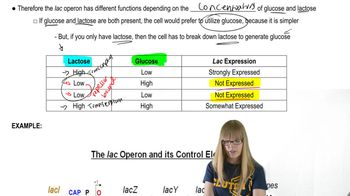How do we know that eukaryotic transcription factors bind to DNA sequences at or near promoter regions?
Table of contents
- 1. Introduction to Genetics51m
- 2. Mendel's Laws of Inheritance3h 37m
- 3. Extensions to Mendelian Inheritance2h 41m
- 4. Genetic Mapping and Linkage2h 28m
- 5. Genetics of Bacteria and Viruses1h 21m
- 6. Chromosomal Variation1h 48m
- 7. DNA and Chromosome Structure56m
- 8. DNA Replication1h 10m
- 9. Mitosis and Meiosis1h 34m
- 10. Transcription1h 0m
- 11. Translation58m
- 12. Gene Regulation in Prokaryotes1h 19m
- 13. Gene Regulation in Eukaryotes44m
- 14. Genetic Control of Development44m
- 15. Genomes and Genomics1h 50m
- 16. Transposable Elements47m
- 17. Mutation, Repair, and Recombination1h 6m
- 18. Molecular Genetic Tools19m
- 19. Cancer Genetics29m
- 20. Quantitative Genetics1h 26m
- 21. Population Genetics50m
- 22. Evolutionary Genetics29m
10. Transcription
Transcription in Eukaryotes
Problem 2
Textbook Question
Write a short essay describing how cis-acting regulatory elements, activators, and chromatin modifiers are all coordinately involved in regulating transcription initiation.
 Verified step by step guidance
Verified step by step guidance1
Begin by defining cis-acting regulatory elements as DNA sequences located near the gene they regulate, such as promoters and enhancers, which serve as binding sites for proteins that control transcription initiation.
Explain that activators are proteins that bind to these cis-acting elements to increase the rate of transcription by facilitating the assembly of the transcription machinery at the promoter.
Describe chromatin modifiers as enzymes or protein complexes that alter the structure of chromatin (e.g., through histone acetylation or methylation), thereby changing the accessibility of DNA to transcription factors and RNA polymerase.
Discuss how these three components work together: cis-acting elements provide specific binding sites, activators recognize and bind these sites to recruit or stabilize the transcriptional machinery, and chromatin modifiers remodel chromatin to create a more open or closed environment for transcription initiation.
Conclude by emphasizing that the coordinated interaction among cis-acting elements, activators, and chromatin modifiers ensures precise spatial and temporal control of gene expression, allowing cells to respond dynamically to internal and external signals.
 Verified video answer for a similar problem:
Verified video answer for a similar problem:This video solution was recommended by our tutors as helpful for the problem above
Video duration:
2mPlay a video:
Was this helpful?
Key Concepts
Here are the essential concepts you must grasp in order to answer the question correctly.
Cis-acting Regulatory Elements
Cis-acting regulatory elements are DNA sequences located near or within a gene that control its transcription. These include promoters, enhancers, and silencers, which serve as binding sites for transcription factors and other proteins, influencing the rate and timing of gene expression.
Recommended video:
Guided course

Human Transposable Elements
Activators
Activators are proteins that bind to specific cis-acting elements, such as enhancers, to increase transcription. They facilitate the recruitment of the transcriptional machinery, including RNA polymerase II, often by interacting with coactivators and the basal transcription complex.
Recommended video:
Guided course

Lac Operon Summary
Chromatin Modifiers
Chromatin modifiers are enzymes that alter chromatin structure through chemical modifications like acetylation or methylation of histones. These changes can either relax or compact chromatin, thereby regulating the accessibility of DNA to transcription factors and RNA polymerase, and ultimately controlling transcription initiation.
Recommended video:
Guided course

Chromatin

 9:16m
9:16mWatch next
Master Eukaryotic Transcription with a bite sized video explanation from Kylia
Start learningRelated Videos
Related Practice
Textbook Question
394
views
